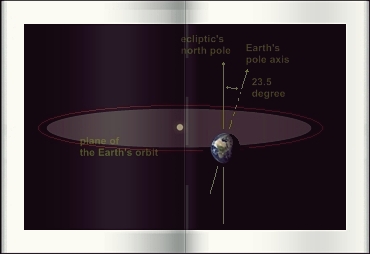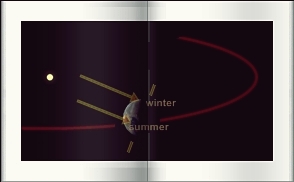
| CONTENT - All about the seasons and how they work |
Seasons are the four main moments of the climate at Earth. It is badly known that seasons are an astronomical phenomenon indeed
Seasons are explained by Earth's orbit and by Earth axis' tilt. The Earth's axis is the line joining Earth north and south poles. It's the axis around which Earth is rotating. This axis is tilted. It is tilted relative to ecliptic. The ecliptic is the plane of the Earth's orbit's around the Sun. Technically, the tilt is computed relative to a perpendicular to the ecliptic. The tilt is about 23.5° in any case

The tilt of the Earth does not vary as Earth is orbiting the Sun. Which makes that at some point of the orbit the axis is tilted away from the Sun as at another point it is tilted towards. Two more positions are when the axis, although tilted still, is neutral relative to the Sun. It is these four main positions -tilt away from the Sun, tilt towards the Sun, tilt neutral, which produce the seasons. This is due to the angles at which the rays of the Sun are reaching Earth being different. When Earth northern hemisphere e.g. is tilted away from the Sun, Sun rays come there at a shallow angle as when the hemisphere is tilted towards the Sun, Sun rays come at a sharp angle. Hence less, or more, heat. The length of days is a cause too. Days are longer during summer and shorter during winter, hence too more or less heat

 | click to the four defining moments of the seasons! |
The motion of the Earth around the Sun, relative to the axis tilt, is characterized by four particuliar moments
The axis tilt determines four peculiar moments along the orbit. These four moments in turn are determining the seasons. As far as Earth's hemispheres are concerned, seasons are reverted. When it's winter North, is summer South e.g. This is due to that when the northern hemisphere is at a given tilt relative to the Sun, the southern hemisphere is correlatively at the opposite tilt. As far as the name's attribute for the solstices and equinoxes are concerned, they follow that of the season in question in a given hemisphere (like that will be used in the text below). In a given hemisphere, generally, daylight ranges from about 15 hours around the summer solstice to around 9 hours close to the winter solstice. Strictly speaking equatorial regions do not have any delineated seasons. Temperatures, vegetation, and the length of days are remaining identical all year long
Another interesting, advanced, point is that Earth's orbit is not exactly a circle but an ellipse. Hence Earth is nearest to the Sun at one point of its orbit and farthest from it at another point. The nearest point is termed the "perihelion", the farthest is the "aphelion". Both words are of Greek origin and mean near ("peri") Sun ("helios"), and far ("a") from Sun. Perihelion differs of aphelion by 3 million miles. Perihelion takes place each year about January, 2nd as aphelion is about July, 4th. Such dates may slightly vary each year, in a random variation. That is due to the Earth-Moon system, as both bodies are orbiting around a 'barycenter,' or a common center of gravity (which is located by 2,900 miles from the Earth's center). Perihelion and aphelion, at the contrary, are measured between both Sun's and Earth's centers. Thus, each year, the Earth is not located at the same place relatively to the Earth-Moon barycenter. As such an inconsistency between the dates of seasons and ones of perihelion and aphelion is of few importance in the northern hemisphere, it is much more important in the southern hemisphere. It's when the southern part of the Earth is tilted towards the Sun that Earth, at the same time, is nearest to the Sun hence southern summers are warmer than northern! On the other hand, the aphelion does not yield colder southern winters however. This might be due to the oceans. Their surface is much more important in the southern hemisphere and they might have a tempering effect. In the northern hemisphere at the time of the summer solstice, the inconsistency between the larger distance from the Sun and the solstice, is fairly balanced by the fact that the length of the day, hence the illumination, is at its greatest. By mid-June, on another hand, the oceans of the northern hemisphere are still cool from winter's chill, delaying the peak air temperatures by about a month and a half. Some places at a high altitude, as far as the longest nights are concerned, are experiencing a sole kind of twilight, the civil one, with the Sun less than 6 degrees below the horizon as the nautical and astronomical kinds (the Sun 12 degrees, the Sun more than 18 degrees below) remain unknown
A other consequence from that the terrestrial orbit is a ellipse is that the part of it journeyed by Earth from spring to fall is slightly larger than the opposite one. Spring and summer thus are lasting a little longer each (92d 19h and 93d 15h, respectively) than fall and winter (89d 20h, 89d 0h). Such proportions and value vary function of how the orbit's perigee is related to the vernal point on the ecliptic. By 1250 A.D. for example, fall was equal to winter and spring to summer)
 | click to the mechanism of precession! |
Earth's orbit and axis are affected by various cyclical variations. Most of these cycles have been described by Milutin Milankovitch, a Serbian scientist in the 1920s, as part of science he was making about the long-term variations of the Earth climate. One of those variations only, the 'precession", is of importance in astronomy, and has been known since a long time. Others are of few interest to astronomers and are just part of the usual orbital fluctuations in a solar system. Periodic variations in Earthís axial tilt and orbit around the Sun have driven the planetís succession of ice ages and warm periods over the past two million years
The precession, as it combines itself to the fundamentals of the Earth's orbit -and even with the other cyclical variations as described above- certainly, obviously impacts, on the long term, the Earth's climate. The shift, on the orbit, of the moments of the seasons, thus, for example, is shifting the relationship between summers and winters, and the aphelion and the perihelion
Website Manager: G. Guichard, site 'Amateur Astronomy,' http://stars5.6te.net. Page Editor: G. Guichard. last edited: 2/9/2015. contact us at ggwebsites@outlook.com